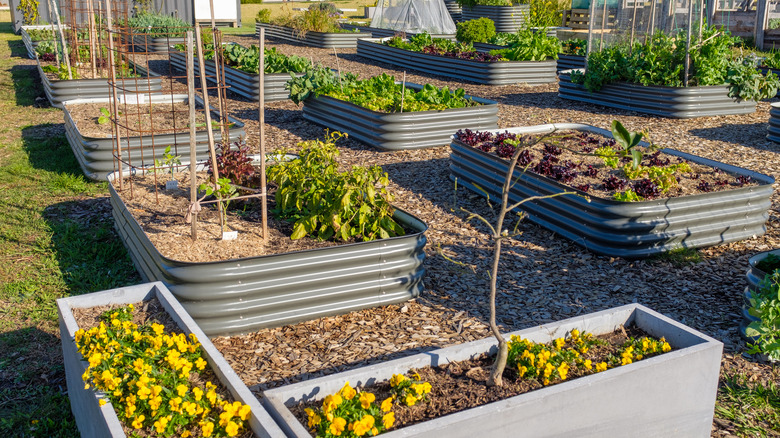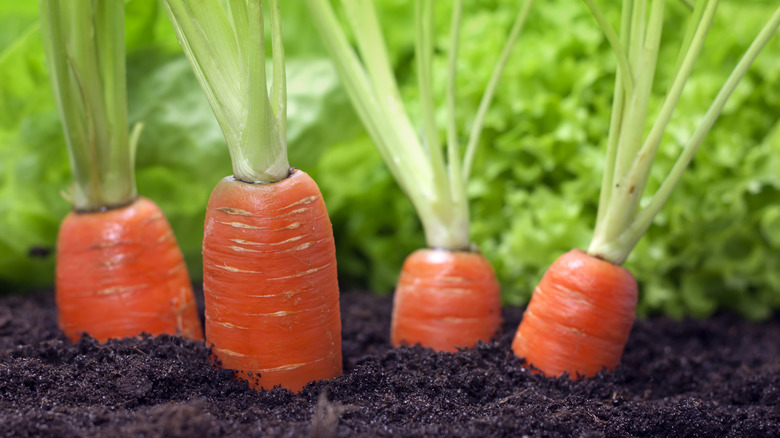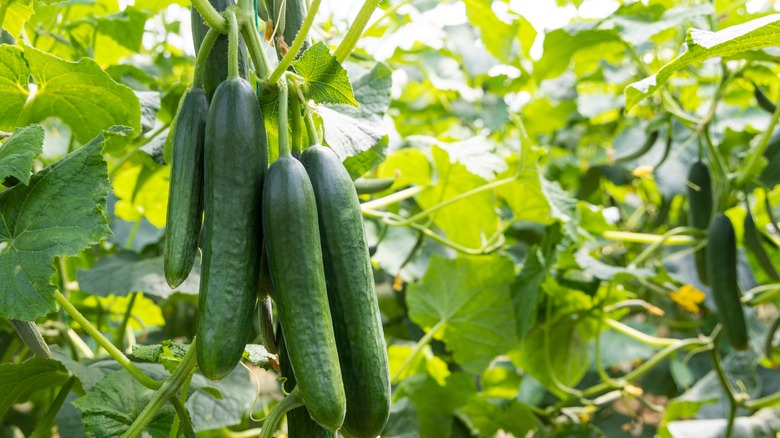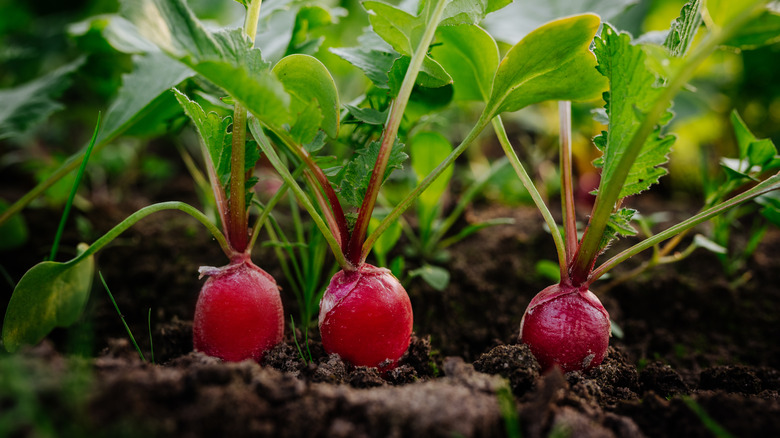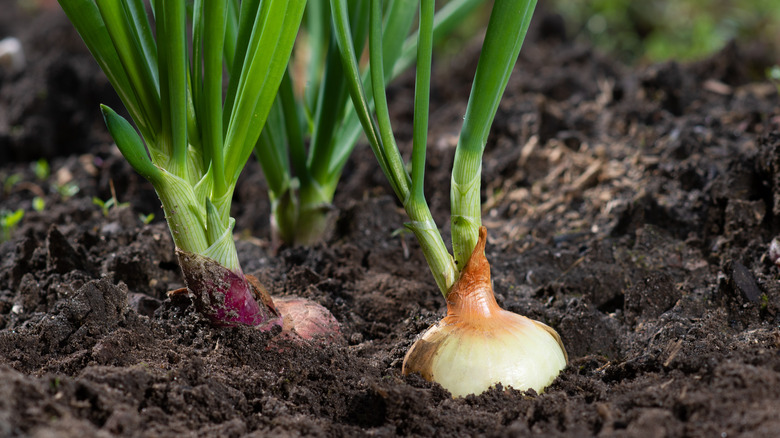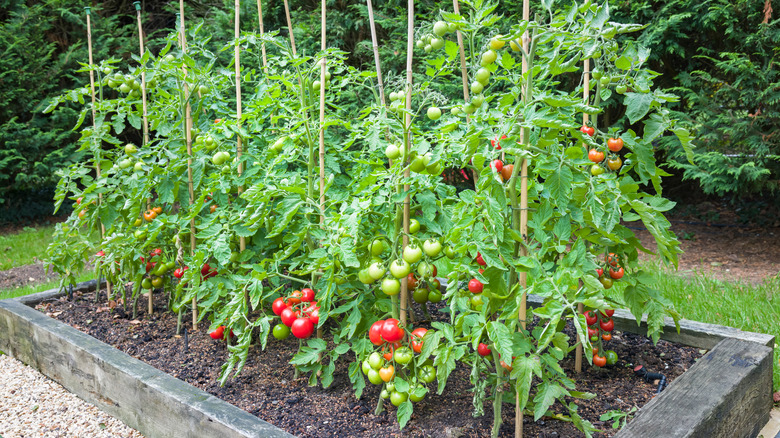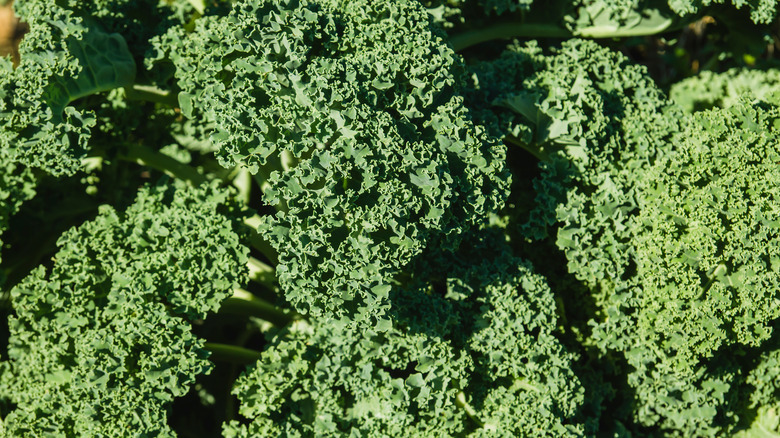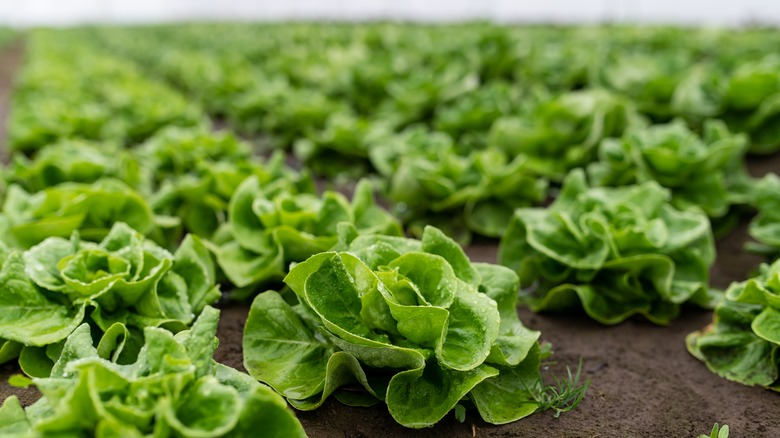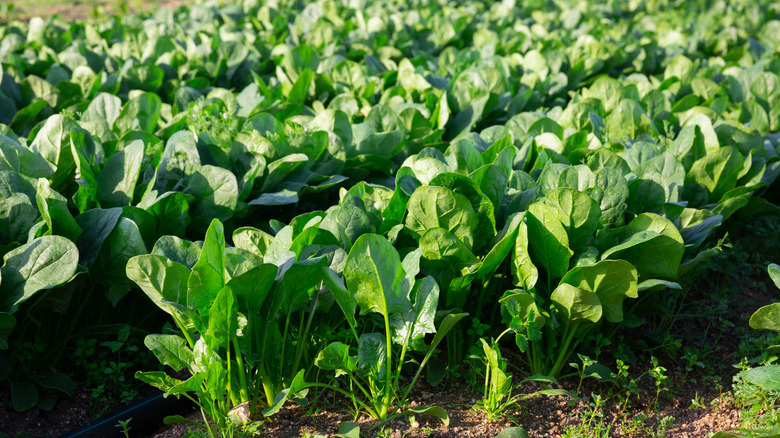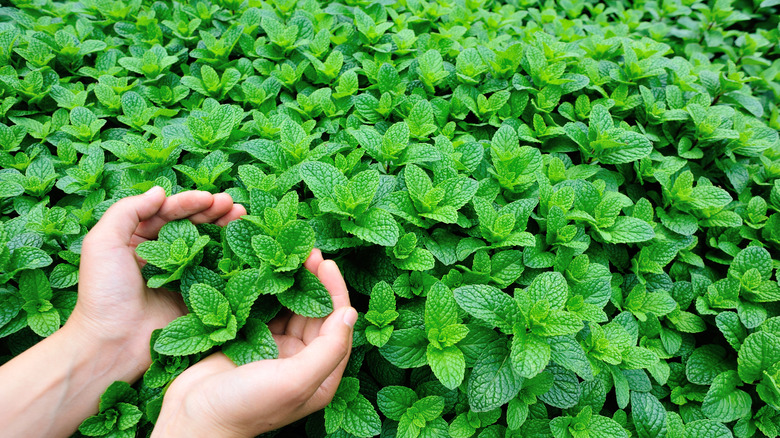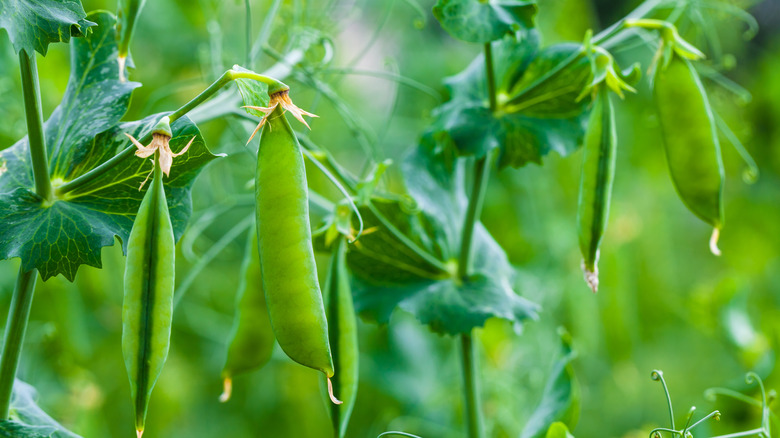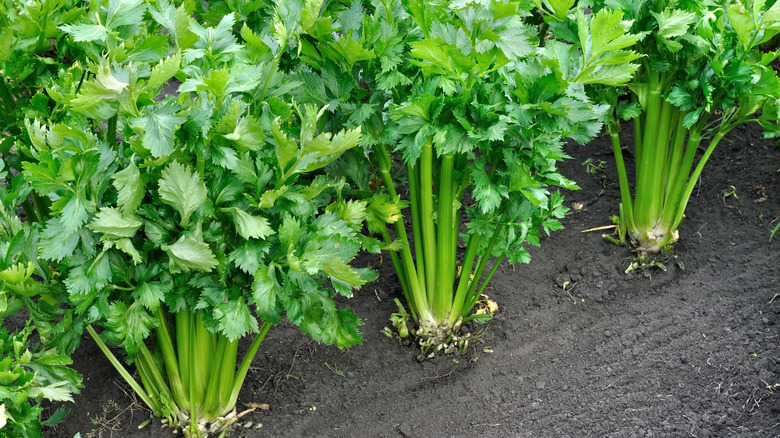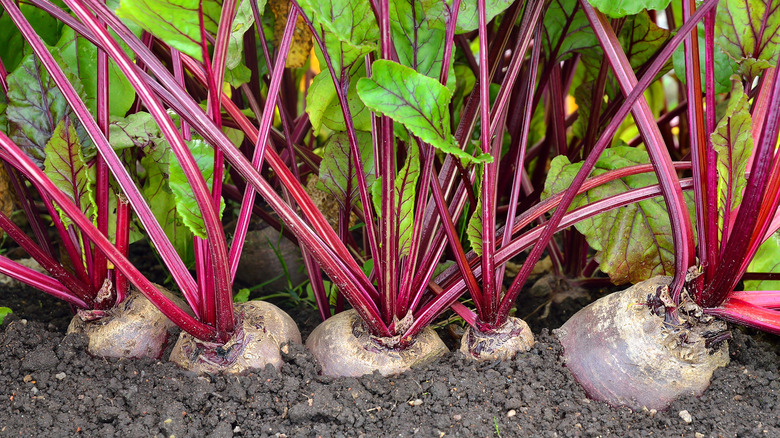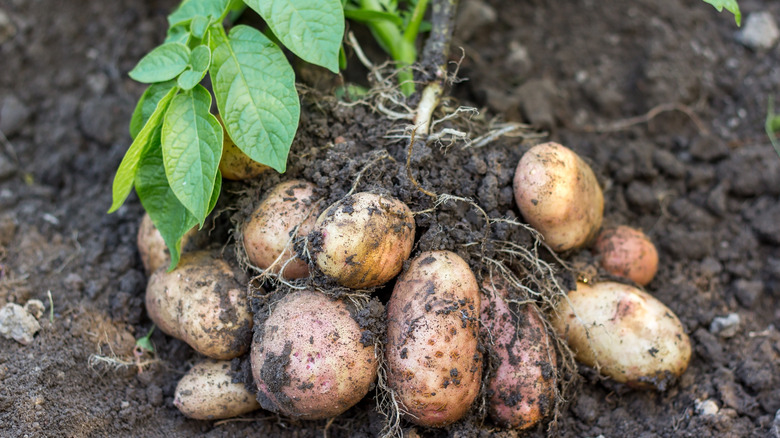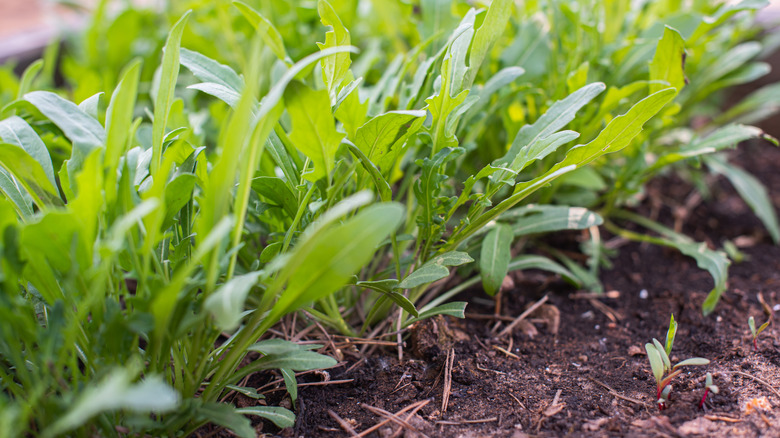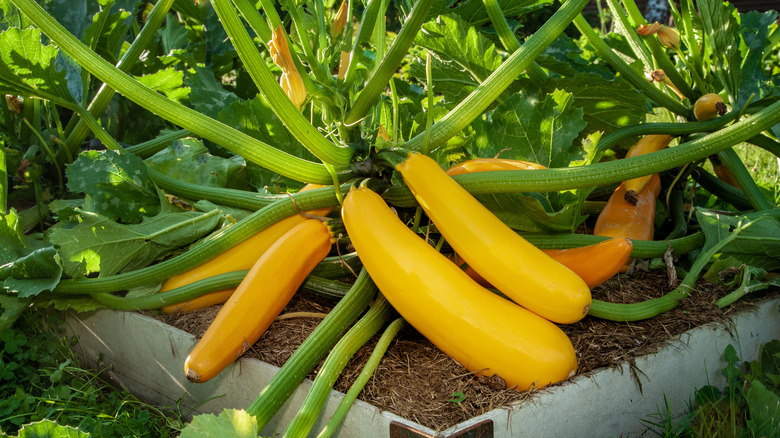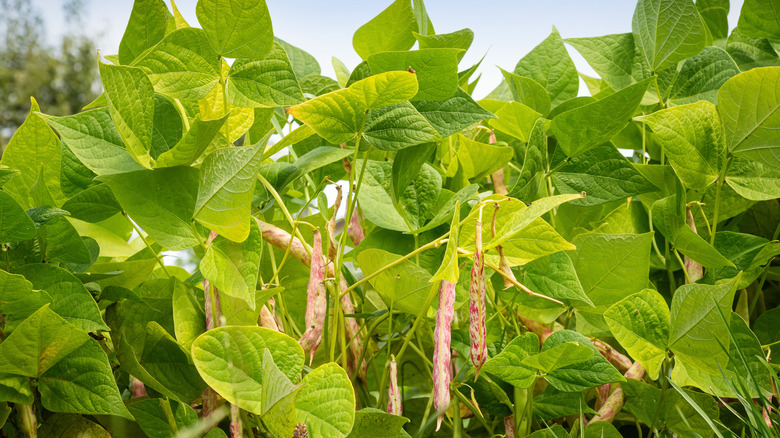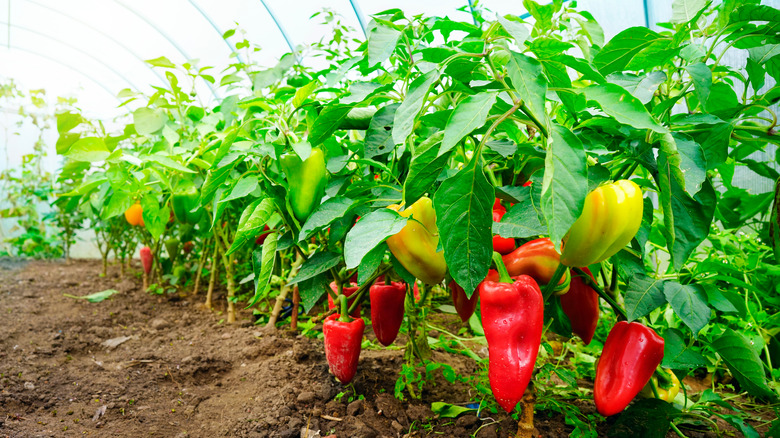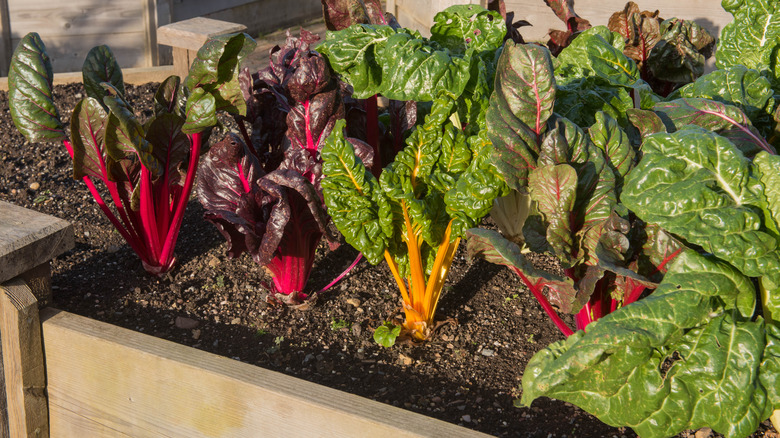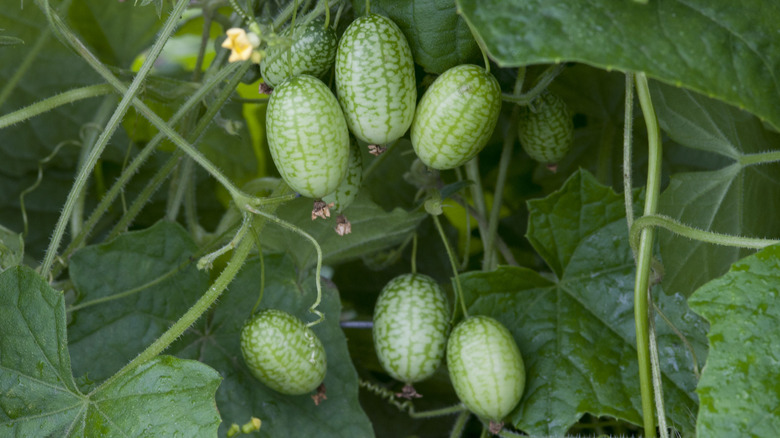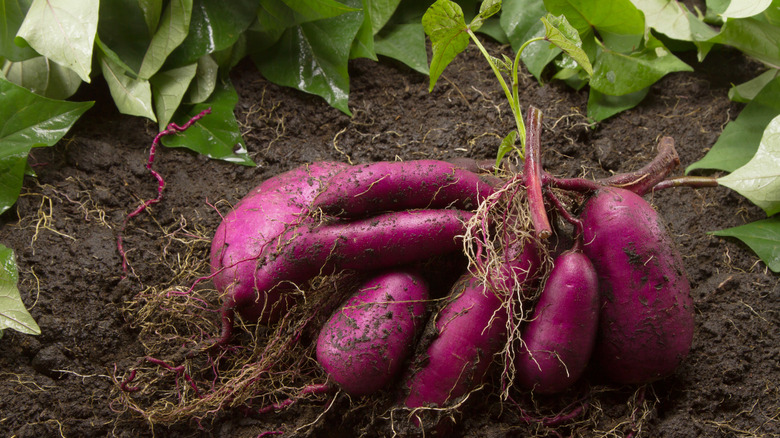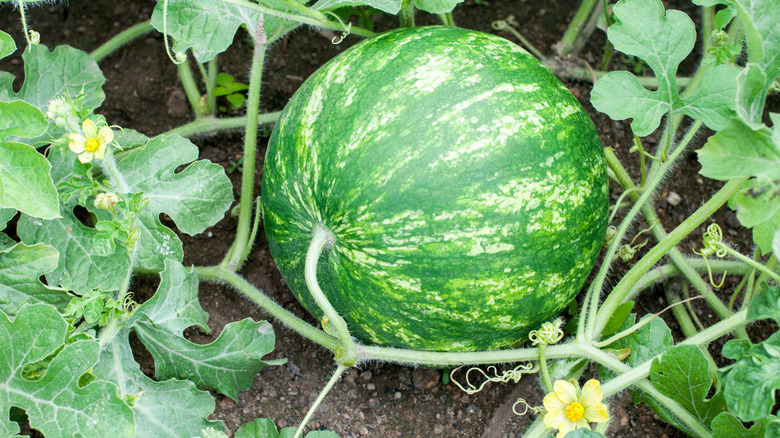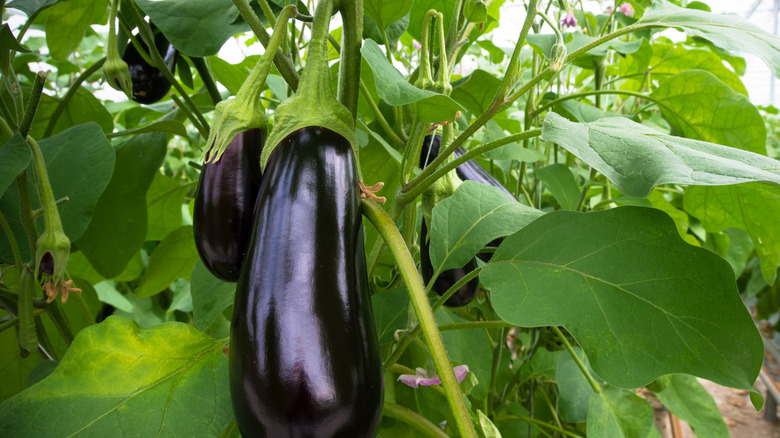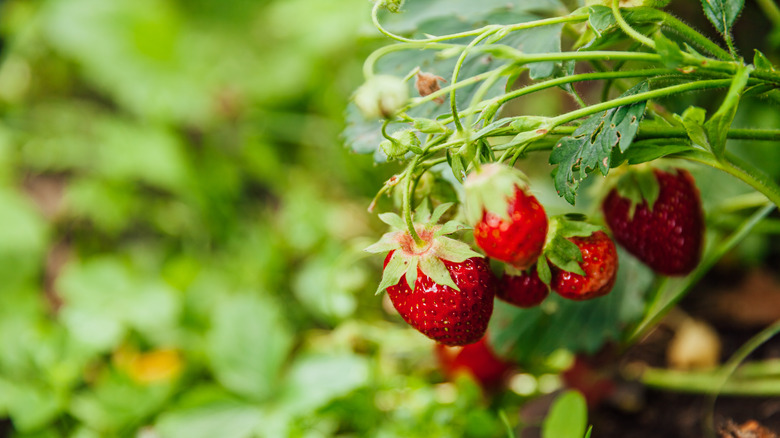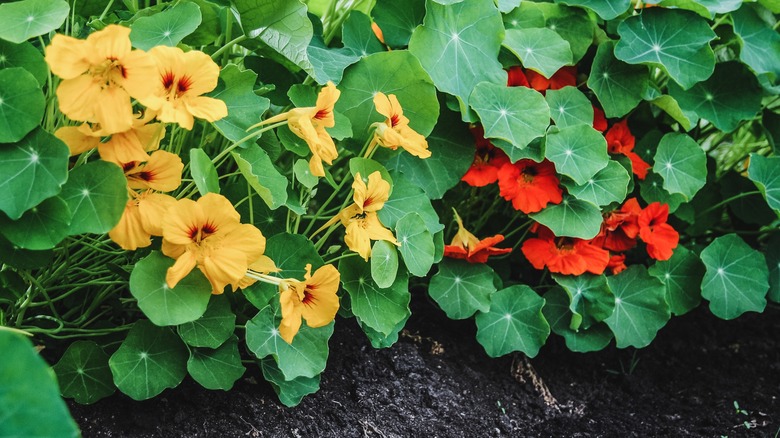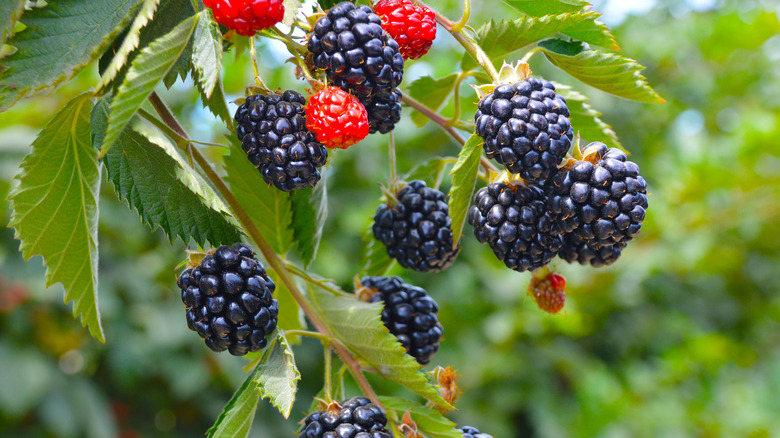25 Plants That Are Perfect For A Raised Garden Bed
Using raised beds is nothing new among avid gardeners; it is a technique that has been in use for centuries to the present day. This gardening style is popular for home gardens, specifically for growing vegetables and fruits. While cultivating your favorite plants in a raised garden sounds fun, zeroing down on the right plants for the garden is easier said than done. Certainly, every plant can benefit from the advantages of a raised bed, but what specific plants will give you the best bang for your buck?
The popularity of growing plants in raised beds is all for the right reasons. According to the University of New Hampshire, some advantages of raised beds are easy maintenance, better soil drainage, and the fact that they are easy on your back. Other than that, growing plants in a raised bed contribute to a relatively higher yield considering the square feet of the growing area. With that out of the way, take a look at the following plants that will do well in a raised bed in your garden.
1. Carrots
Carrots (Daucus carota) are a great source of vitamin A. They are not only easy to grow but also require little maintenance, via the University of Florida Gardening Solutions. Because carrots are root vegetables, they need the right soil conditions for proper root growth. They will benefit from the well-aerated and loose soil on raised beds that encourages proper root growth.
Bloom Season: Spring
USDA Growing Zone: 3 to 10
Growing Conditions: Full to partial exposure
Soil Type: Loose, well-drained
Size: Up to 1 foot tall and 9 inches wide, 6 to 12 inches root
2. Cucumbers
Another good plant for a raised bed is the cucumber (Cucumis sativus). This particular plant is available in two varieties: bush and vining. Vining cucumbers will be an excellent option if you have a small bed. Use trellis and train them to grow vertically to save on space. This particular plant prefers loose, well-drained soil, making them perfect for your raised garden, via the University of Georgia Extension.
Bloom Season: Seasonal
USDA Growing Zone: 4 to 11
Growing Conditions: Full to partial exposure
Soil Type: Rich, well-drained
Size: 9 to 18 inches tall, 3 to 8 feet wide
3. Radishes
Radishes (Raphanus sativus) are root vegetables available in different varieties other than the small red types. Besides being easy to grow and care for, radishes also mature fast, approximately 25 to 35 days, via the University of Maryland Extension. This will allow you to grow them alongside other plants that take longer to mature in your raised bed.
Bloom Season: Summer
USDA Growing Zone: 2 to 11
Growing Conditions: Full to partial exposure
Soil Type: Rich, well-drained
Size: 4 to 14 inches tall, 3 to 14 inches wide
4. Onions
The regular onion (Allium cepa) is made for raised beds because they require rich, well-drained, and aerated soil — characteristics these elevators bring. According to Texas A&M AgriLife Extension Service, onions should be planted in beds 4 inches high and 20 inches wide. Other than that, consider growing onions with other veggies because they help ward off some pests from your garden.
Bloom Season: Summer
USDA Growing Zone: 5 to 10
Growing Conditions: Full exposure
Soil Type: Rich, well-drained
Size: 12 to 18 inches tall, 6 to 12 inches wide
5. Tomatoes
Tomatoes (Solanum lycopersicum) are among the most popular plants for home gardens. Tomatoes are among the few plants that will give you a bang for your buck for every square inch they take in your garden. They require rich and well-drained soil for proper growth, via the University of Hampshire. This makes them the right candidate for growing in raised beds since you can quickly amend the soil according to the plant's needs.
Bloom Season: Summer
USDA Growing Zone: 2 to 11
Growing Conditions: Full sun
Soil Type: Rich, well-drained
Size: 3 to 4 feet tall, 1 to 3 feet wide
6. Kale
Another popular plant among gardeners is kale (Brassica oleracea). This green vegetable is not only appealing to the eyes but also packs a punch when it comes to nutritional value, mentions the University of Florida Gardening Solutions. Although kale is a cool season plant, it also prefers some controlled exposure to sunlight. Because of this, you can easily plant them in the same raised bed with tomatoes for some shade.
Bloom Season: Spring
USDA Growing Zone: 7 to 9
Growing Conditions: Partial sun
Soil Type: Rich, well-drained
Size: 1 to 2 feet tall, 1 to 2 feet wide
7. Lettuce
Another welcome addition to your raised bed is the lettuce (Lactuca sativa) plant. Although it is a small plant, it is among the hardiest vegetables and able to withstand limited exposure to frost. It is suitable for a raised bed because you can grow it with other plants. Because lettuce is a small plant, it fits into small spaces and matures earlier than others, via the University of Wisconsin-Madison Division of Extension.
Bloom Season: Seasonal
USDA Growing Zone: 2a to 11b
Growing Conditions: Full to partial sun
Soil Type: Loamy, well-drained
Size: 6 to 12 inches tall and wide
8. Spinach
Other than lettuce, another cool-season plant that is perfect for a raised bed is the spinach (Spinacia oleracea) plant. While that is true, you should be aware that the spinach plant has shallow roots therefore you need to provide enough water to the plant, via Cornell University. Fortunately, in a raised bed you will be able to amend the soil and also closely monitor the water requirements of your plants.
Bloom Season: Summer
USDA Growing Zone: 2 to 11
Growing Conditions: Full to partial sun
Soil Type: Moist, well-drained
Size: 6 to 12 inches tall and wide
9. Mint
Mint (Mentha spp.) is an excellent plant for novice gardeners, they are not only easy to grow but also almost hands-free as far as maintenance is concerned. While it is nice to have this herb in your garden, the only downside is its ability to spread aggressively, mentions the University of Florida Gardening Solutions. The good news, however, is that growing mints in a raised bed will allow you to control their growth easily and prevent unwanted invasions in your garden.
Bloom Season: Summer
USDA Growing Zone: 3 to 11
Growing Conditions: Full to partial sun
Soil Type: Loamy well-drained
Size: 12 to 18 inches tall, 18 to 24 inches wide
10. Peas
Pea plants (Pisum sativum) are popular because of their little maintenance and the fact that they can be harvested as early as 50 days, via The Pennsylvania State University. This cold-season plant comes in several varieties, making it possible to find the perfect one for your raised bed. For the tall types, be sure to use stakes or trellis to facilitate vining.
Bloom Season: Spring, fall
USDA Growing Zone: 2 to 11
Growing Conditions: Full to partial sun
Soil Type: Moist, well-drained
Size: 12 to 18 inches tall, 6 to 12 inches wide
11. Celery
While the celery (Apium graveolens) plant is relatively difficult to grow, they are a staple for most meals, making the rather tedious maintenance worthwhile. Fortunately, the kind of care and maintenance celery requires is easily achievable on raised beds. They have a shallow root system that requires consistent moisture and rich soil, according to the Utah State University Yard and Gardening Extension. It will be easier to tend to these plants on raised beds than in an open garden.
Bloom Season: Summer
USDA Growing Zone: 2 to 10
Growing Conditions: Full to partial sun
Soil Type: Moist, rich well-drained
Size: 12 to 18 inches tall
12. Beets
The beet plant (Beta vulgaris) is another good option for your raised bed. Although popularly grown for their bulbous roots, the green leafy foliage is also used as food. This plant is ideal for a raised bed because of its care requirements. According to South Dakota State University Extension, this plant requires proper irrigation on well-drained soil. Raised beds have less compact aerated soil, which facilitates proper water drainage.
Bloom Season: Seasonal
USDA Growing Zone: 2 to 11
Growing Conditions: Full to partial sun
Soil Type: Moist, well-drained
Size: 12 to 18 inches tall, 18 to 24 inches wide
13. Potatoes
Homegrown potatoes (Solanum tuberosum) taste better than those bought from the store. They come in several varieties that can be grown in your home garden. While potatoes can grow almost everywhere, planting them in raised beds makes it easier for you to dig up during harvesting. Also, potatoes require well-aerated soil; Cornell University recommends using raised beds for clay and poorly aerated soil.
Bloom Season: Seasonal
USDA Growing Zone: 3 to 10
Growing Conditions: Full sun
Soil Type: Rich, well-drained
Size: 1½ to 3 feet tall and wide
14. Arugula
Another regular member on your plate of salad is arugula (Eruca sativa). This particular plant is easy to grow right from your home garden, and arugula thrives in cool temperatures away from direct afternoon sunlight as a cold-season vegetable. Like other green leafy veggies, arugula needs well-aerated soil and proper irrigation for optimal growth, mentions the University of Wisconsin-Madison Division of Extension.
Bloom Season: Seasonal
USDA Growing Zone: 2 to 11
Growing Conditions: Partial sun exposure
Soil Type: Rich, well-drained
Size: 2 to 3 feet tall and 1 to 1½ feet wide
15. Summer squash
The summer squash plant (Cucurbita pepo) is an excellent addition to your raised bed. This is because they mature faster and are ready for harvest as early as 40 days after planting, via the University of Florida Gardening Solutions. Also, summer squashes are bountiful producers, particularly the shrub varieties, for instance, bush zucchinis. They will give you a bang for your buck even when grown in tight spaces like small raised beds.
Bloom Season: Summer
USDA Growing Zone: 3 to 10
Growing Conditions: Full sun
Soil Type: Loamy, well-drained
Size: 2 feet tall, 3 to 4 feet wide
16. Beans
The regular bean plant (Phaseolus vulgaris) comes in plenty of varieties, including climbing, bush, and trailing types, via the North Carolina Extension Gardener Plant Toolbox. The good news, however, is that all of the varieties can be planted in a raised bed. The bush type is ideal if you don't have a trellis; however, the other two will need some form of support to allow them to climb and grow vertically.
Bloom Season: Seasonal
USDA Growing Zone: 2 to 11
Growing Conditions: Full sun
Soil Type: Loamy, well-drained
Size: 2 to 15 feet tall, 2 to 3 feet wide
17. Peppers
Belonging to the Capsicum annuum species, there is no denying the importance of both hot and sweet peppers in meals. These plants are relatively easy to grow and can even be combined with your tomato plants in the same raised bed. The University of Florida Gardening Solutions mentions that these veggies thrive in full sun and require well-aerated soil for optimal growth.
Bloom Season: Spring, summer
USDA Growing Zone: 9 to 11(grown as annuals)
Growing Conditions: Full sun
Soil Type: Loamy, well-drained
Size: 1 to 5 feet tall, 1 to 3 feet wide
18. Swiss chard
Often confused with spinach, the Swiss chard (Beta vulgaris var. cicla) is a beet with no bulbous roots. While the Swiss chard is predominantly grown as a vegetable, it can also be grown alongside flowers for ornamental purposes, via the University of Wisconsin-Madison Division of Extension. Nonetheless, this plant is easy to grow in a raised bed or a container, and the foliage is ready to be used as food immediately after they get large enough.
Bloom Season: Summer
USDA Growing Zone: 6 to 10
Growing Conditions: Full to partial sun
Soil Type: Rich, well-drained
Size: 18 to 24 tall, 9 to 12 feet wide
19. Cucamelon
Often described as the mouse melon or the cucamelon (Melothria scabra), this plant looks like a miniature watermelon. They are not only easy to grow and maintain but are also relatively fast growers, via the University of Wisconsin-Madison Division of Extension. If you are a cucumber fan but don't have the space for them, the cucamelon plant will be an excellent alternative for your raised bed.
Bloom Season: Summer, spring
USDA Growing Zone: 2 to 11
Growing Conditions: Full sun
Soil Type: Rich organic, well-drained soil
Size: up to 1 foot tall, 10 feet wide
20. Sweet potatoes
Unlike regular potatoes, the sweet potato plant (Ipomoea batatas) is grown from potato slips. However, both types of potatoes have similar soil requirements: rich, well-aerated, drained soil. This is particularly important for sweet potatoes to grow big and deep tubers. Although considered drought tolerant, it is ideal for providing this plant with a consistent water supply, via the University of Georgia Extension.
Bloom Season: Summer
USDA Growing Zone: 8 to 10
Growing Conditions: Full to partial sun exposure
Soil Type: Rich organic, well-drained soil
Size: 2 to 20 feet long
21. Watermelon
The watermelon (Citrullus lanatus) is for sure a summer treat. This plant is region-specific, only thriving in prolonged, extended hot weather areas. However, if you live in cooler regions, other varieties mature faster. Growing melons in a raised bed are better than on a regular vegetable farm. This is because the loose soil will facilitate proper drainage, which is essential for the growth of watermelons, via Cornell University.
Bloom Season: Summer
USDA Growing Zone: 2 to 11
Growing Conditions: Full sun exposure
Soil Type: Loamy, well-drained soil
Size: 6 to 8 feet long
22. Egg Plant
The Eggplant (Solanum melongena) can be used for food and ornamental purposes. This particular plant is easy to grow and care for, and they love hot weather and should only be planted when there is no frost. The University of Florida Gardening Solution recommends growing this plant in raised beds for the sake of proper aeration and also because raised beds don't require you to prewarm the soil.
Bloom Season: Summer
USDA Growing Zone: 9b to 12a
Growing Conditions: Full sun exposure
Soil Type: Loamy, well-drained soil
Size: 2 to 4 feet tall, 1 to 3 feet wide
23. Strawberries
The beauty of growing strawberries (Fragaria x ananassa) is that you don't need ample space to start. While the strawberry plant may appear delicate and dainty, it is tough with minimal maintenance requirements, via the University of Georgia Extension. However, you need to be aware of its spreading habit; the good news is that growing strawberries in raised beds will make it easy for you to control their growth over the years.
Bloom Season: Spring, early summer
USDA Growing Zone: 4 to 9
Growing Conditions: Full sun exposure
Soil Type: Rich, well-drained soil
Size: 4 to 12 inches tall, 6 to 24 inches wide
24. Nasturtium
The nasturtium (Tropaeolum majus) plant is not a regular flower; it will provide your outdoor garden area with the necessary pomp and color. The interesting bit is that the leaves and flowers are also edible. Because of this, you can incorporate them in your raised bed together with other plants. However, the University of Wisconsin-Madison Division of Extension recommends growing them in beds with enough sun.
Bloom Season: Spring, summer, fall
USDA Growing Zone: 9 to 11
Growing Conditions: Full sun exposure
Soil Type: Moist, well-drained soil
Size: 1 to 10 feet tall, 1 to 3 feet wide
25. Blackberries
The blackberry plant (Rubus Fruticosus) is popular among home gardeners because it is one of the easiest to grow and care for. This plant is so hands-free that you can easily get away with minimal neglect. The Ohio State University recommends growing blackberries in raised beds because they need space and rich organic soil for proper root development.
Bloom Season: Spring
USDA Growing Zone: 5 to 8
Growing Conditions: Full sun exposure
Soil Type: Rich, well-drained soil
Size: 3 to 5 feet tall, 3 to 10 feet wide
